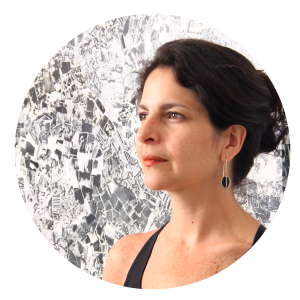STATEMENT
My work is based on torn pieces of paper from discarded books, fragmented and recomposed into a new unit/object through the collage technique. I have called it White Noise, because of its similarity to the optical effect perceivable on an analog TV sets when tuned to blank channels. The term is linked to white light, which contains all frequencies of visible spectra, and to noise, a polysemy concept related to disorder, irregularity, and error.
I am profoundly interested in the visual phenomena that results from randomness and absence of correlation between images and the sensorial and perceptual response that this fragmented images generate; how they trigger processes of connectivity in our memory and subconscious as well as producing optical vibrations that results from the conjunctions of fragments, textures, and graphic languages in each work. The dialectic that happens between shapes and the different contrasts between black, white and various shades of grey, as well as the density resultant of superimposing different layers, produce a visual texture in which the eye is very attracted and stimulated. The vintage perception of the chemical changes in the paper structure evokes a sight to the past.
The sensorial and perceptual impressions these fragmented images produce and how they formulate processes of connectivity in our memories are very important. White Noise is the vehicle that allows me to accentuate this experience in my work. While deconstructing the book -container of graphic languages, imaginary and cultural narratives, related to places, categories, and ideas- I explore strategies that activate the interpretative space while fragmenting and re-editing the images. I modify their syntaxis, altered perceptive codes and aleatorily reconstruct their semantics. We belong to a visual culture in which visual noise is overwhelming; a new order is formulated as a result of this exploration.
The noise overload we experiment, forces us to concentrate on something truly significant, to abstract ourselves from numerous interferences; scanning a surface of multiple images and finding correlations, patterns and connections among them. Every fragment, form, and value is the beginning of a new relation, small accounts contained in a larger visual content: the extended narrative of the book/image/process. Its beginning and end are determined by the process of transmuting noise into something new, significant, perplexing and exciting to the observer.
BIO
ANA ALEXANDRA MORENO (CARACAS, 1972). She studied Visual Arts at Universidad Nacional Experimental de las Artes (Caracas), and has been involved with Venezuelan institutions developing international venues. As a performer, Moreno has been actively collaborating with groundbreaking theater companies such as “Altosf – Theater of the Unknown”, and “Centro del Movimiento Creador”, both based in Venezuela. Moreno has been invited to do several Artist in Residence programs in Argentina, including the 1st International Encounter CMC – Creando (Buenos Aires), and Curatoría Forense (Rosario), in 2011. Her current projects focus on collage and sculpture. She had two solo exhibitions in Caracas: Centro de Arte el Hatillo (2017) and L’Alliance française (2018).

